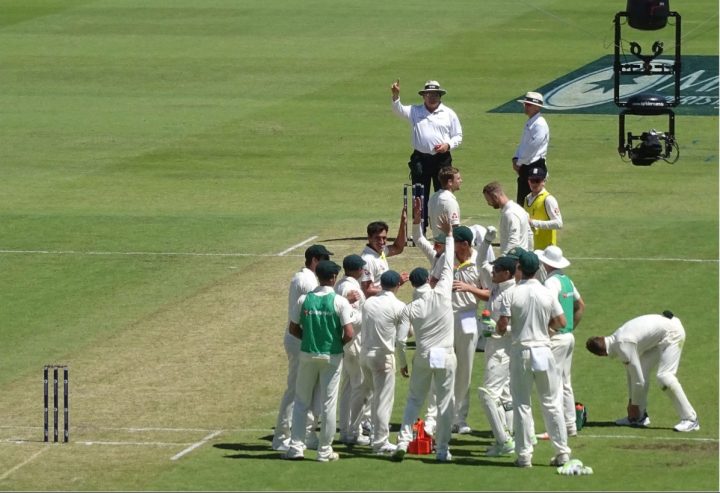Have you heard the news? Those crazy cats at the ECB have arranged a North versus South series in the UAE next March. There will be three games every year until 2019 to help England’s fringe players prepare for the next World Cup. I’m not sure why they’re trying to help the ODI side, rather than the test squad, but there we go.
Although I’ve been cautiously optimistic about several innovations proposed by Strauss and the new ECB suits recently, I’m afraid this one smacks of innovation for innovation’s sake. It’s almost as if Lord Brocket is saying to the world “hey look at me, the funky conservative”.
The fact that four players from each side will be selected by a computer algorithm – they’ll be using the PCA’s most valuable player rankings – smacks of Moneyball on steroids. I wonder whether Strauss’ penchant for statistics is clouding his judgement on this one?
Although I’ve often thought that a regional competition is a good idea in theory (it works well at junior levels) I really don’t understand the need for this one – at least not in its current guise. For starters, conditions in the UAE in March are entirely different to England in early summer – which is when the 2019 World Cup will take place (it begins on May 30th).
What’s more, with England players unlikely to be available anyway (we have an ODI series against the Windies lined up immediately before this North versus South experiment) one wonders whether it would be better to play the trial match later in the summer when more England players will be able to take part. The tight schedule has never prevented Lions fixtures from taking place in summer months, so why should this new series be a problem?
My main beef, however, is the use of a computer formula to select the teams. Although the selectors will cherry pick half the players using nothing but their own judgement (and it’s a good thing that they’re reserving a place on each team for the top spinners available) I’m not sure that asking R2D2 to pick the other half is wise at all.
Although the PCA’s system offers a more sophisticated insight than mere batting and bowling averages – it takes into account things like strike-rates, the percentage of a team’s runs made by a particular batsman, and the number of top order players dismissed by bowlers – it will never be able to judge things like potential and natural talent.
Certain journeymen pros can be very consistent in county cricket but lack the X-factor needed at international level. For example, if you look at last year’s statistics, the qualifying players would have included Wes Durston and Benny Howell. These guys are very useful domestic players, but there’s little point in England having a closer look at them.
Unfortunately this whole North versus South idea has more holes than The Belfry. While players who have retired from international ODI cricket won’t be considered, there’s still every possibility that players who have been dropped by England (and stand little chance of a recall) will have to be selected if the computer says so. For example, Ravi Bopara would also have qualified on last year’s performances. What if Jade Dernbach, Harry Gurney (or even Kevin Pietersen!) do the same in future years?
Although Strauss has done his best to put a positive spin on his new initiative, I cannot agree with his perspective:
This is a good opportunity for England, domestic players and the game … finding the best players outside the current England set-up, playing them against each other in overseas conditions and placing them in an England environment will help us see if they’re ready for international cricket.
The problem with his argument, as far as I can see, is that algorithms (and averages) don’t always highlight who the best players are. Only a set of human eyes can do that. As for creating an ‘England environment’, what he really means is ‘taking cricketers away from their counties and playing with relative strangers in a strange place for a few days’. It’s hardly going to sort the wheat from the chaff, is it.
Meanwhile, I’m not sure that Moneyball theories (and we all know that Strauss is a big fan of the book) to international cricket is a worthwhile exercise. The whole point of Moneyball, for those who haven’t read it, is that statistics are a good way to identify players undervalued by the market. This enabled the Oakland A’s baseball team to assemble a low-budget side that punched well above its weight.
Picking players for international sport doesn’t work the same way. Firstly, there are no budget restrictions (or wage structure) to consider. Strauss isn’t operating a business that’s trying to outmuscle wealthier opponents. Secondly, and this is the key point here, the Oakland A’s used statistics accumulated at domestic level to assemble a squad to play at domestic level; therefore these players were known quantities to a certain extent. What Strauss is trying to do, in effect, is use statistics accumulated at domestic level to pick an international XI. The methodology is therefore flawed. Nobody has any idea whether the players who top the PCA rankings have the ability to perform at a higher level.
Unfortunately, I sense all the PCA statistics actually do is demonstrate which players are playing well at county level. One shouldn’t need a computer algorithm to do this. Keeping an eye on county scores, watching prospects live, and talking to county coaches – you know, the traditional methods of selection – do this just as well (if not better). Using a new computer-based system might pique the interest of some cricket fans, but cynics will see it as nothing more than a valueless gimmick.
Finally, I wonder whether stressing the importance of individual rankings might encourage selfishness in players? Although we can’t stop certain players from ‘playing for their average’, formalising international selection according to statistics seems a tad dangerous to me. The ECB, and Strauss in particular, have long stressed the importance of team ethics and culture in team selection; therefore picking players exclusively for their domestic stats seems rather contradictory – unless, of course, they’ve done a U-turn and now believe that runs and wickets win matches (as opposed to team spirit) after all.
James Morgan









So I’m going to start out trying to be fair to Strauss, whom I’m not fond of:
The “North vs South” is clearly templated on the “State of Origin” in Aussie RL – so one could say it’s a proven tactic to build a bridge between club level and international. Now I still wouldn’t have chosen this approach, but fair enough that we’re trying something. There isn’t that much room in the schedule to make domestic 50 over games more important.
As for the computer, it’s probably not going to change the world, but a bit of diversity in consideration can hardly be a bad thing for England. As you say “nobody has any idea whether the players who top the PCA rankings have the ability to perform at a higher level” – but this might let us find out – and along the way bring a bit more interest and attention to the county game.
Agree with James (especially good on ‘Moneyball’). The idea seems mainly designed to provide material for Twitter wags like Dave Tickner:
https://twitter.com/tickerscricket/status/729592626555572224
Part of me thinks this is a good idea and yes a sort of state of origin match would be good. But a one off game in the middle of nowhere. A one day game as well. Untelevised I bet. What’s the point? One day you can be lucky, another not. How can you judge someone in those circumstances?
Wouldn’t it just be easier to have a game between England and The Lions? Now that would put the cat amongst the pigeons.
That would be good!
When reading this I thought to myself “Why so cynical, James? Why shouldn’t a computer be able to pick (50% of) a team based on sound statistical information ?” but then I found myself finally agreeing with you once I got to the final paragraph.
Will the computer take into account the number of times a player was tasked with accelerating the run rate, and therefore had to play some more extravagant and expansive shots, and thus got out more, affecting his average (although may be reflected in an improved strike rate), than he would have done had the game situation been different ?
Exactly. I wonder how many times the leading run scorer / wicket taker in the domestic competitions is ignored by the England selectors (and with good reason). If a player is ignored despite topping the averages, why should he suddenly earn selection simply because a different statistical measurement says so?
It just makes no sense to me. Jack Brooks and Chris Rushworth, for example, are always amongst the best performers in county cricket every year (as is Darren Stevens for that matter!) yet they’re ignored presumably because they’re not quick enough for test cricket. Why should they now get a gig simply because Andrew Strauss has a penchant for statistics? The logic that led to their exclusion is still sound and applicable.
I don’t think our national selectors are infallible in any way, but why should well considered judgements by highly qualified observers be overruled by a computer?
If you’re going to arrange a North versus South series, just pick who you consider to be the best players and get on with it. Why undermine the integrity of the process, and include a few journeymen like Durston etc, just because you think it will be interesting to do so?
This whole experiment suggests to me that Strauss believes that the best way to select cricket sides is a fusion of subjective judgements (no matter how popular) with statistical data. That’s just daft in my book. England have become more successful over the last year or so precisely because they’re moving away from a statistical approach.
To be honest though, I’m not sure ignoring Brooks has done England any favours. He’s not better than Broad/Finn/Anderson, but he’s up there with most of the backups. At the very least, he’d have put in a shift in the nets that would have required people like Jordan and Woakes to actually perform well to get into the team.
There is a level of gimmickry to this and as a data nerd I would love to hear more details about how the algorithm would work, but there are some things that I do like about the concept.
Given that on average, the 18 counties use over 300 players in ODI competitions every season, the massive difference in quality makes it difficult to identify who the best players are, much less give the best players outside the England set up a window to show how they handle a higher standard of competition. A North vs South trial series should theoretically give the selectors / management an opportunity to see them in action.
I’ve always thought the champion county vs MCC select a bit of a limited exercise – not sure if this is going to replace that, but I’d see this as a far more worthwhile series. Whether the North v South element adds a bit of spice or edge to the contest remains to be seen, but that can only be a good thing if it does.
Obviously the part that’s gaining the headlines is the computer algorithms, but the selectors will still be choosing 14 of the 22, which is around two-thirds, so the computer-based part of the selection is limited. I assume that algorithms will be used in the same way that the ICC world rankings use algorithms to award a value based on relative performance (i.e. 100 off 110 balls in a total of 200 is liable to be worth more than 100 of 80 balls in a total of 400). I assume average totals / run rates / wicket strike rates at different grounds will be taken into account as will a player’s value to their team (potentially allowing an avenue for players in weaker teams to be considered?).
What it does to a certain extent is take some selections out of the selectors’ hands which may reduce accusations of selector bias levelled at the likes of Newell and Fraser. It means that players can get involved in this trial match regardless of age.
Obviously it’s all dependant on what names the computer spits out and the quality of the matches. I think it’s a worthwhile experiment.
Hi Hamish. You make some good points. I’m not against the spirit of experimentation but I’m just not convinced that an algorithm, no matter how sophisticated, can be a substitute for eyes and ears on the ground. It’s not too difficult to work out who the best county performers are, it just requires a little effort and research. Consulting a computer generated programme could be considered ‘selection made easy’ or ‘selection by numbers’ (literally)!
I don’t think I’d be as opposed to the idea if only one player was chosen according to the PCA rankings. Half the side seems too many. I basically see this experiment as a gimmick, so I’d limit the computer’s influence to just one guy. This would still raise interest in the PCA rankings, and reward their MVP (or whatever title he’s given) without undermining the integrity of the matches. Just my 2p.
US sports go in for all star games (although granted this isn’t quite the same) . How are the squads for those games chosen?
I know the NFL Pro Bowl teams are chosen by a public vote. It’s a bit of a rubbish system as fans tend to vote for players they know and love rather than the guys who have performed best in that particular season.
In the UAE? In front of three men and a camel? And probably only on Sky. Any innovation should be trialled in the UK, where there are serious concerns about the future of cricket. Playing matches in the Middle East will do little to generate spectator support at home.
I’m not sure a formula designed to get Samit Patel in front of the selectors again is quite as compelling as Strauss seems to imagine.
Meanwhile Cook’s replacement is improving his captaincy:
http://www.espncricinfo.com/county-cricket-2016/content/story/1012439.html
Only a matter of time….
I asked this question a while back. The general consensus was he’d take over in May 2017 after our tough tour of India.
I wouldn’t want to wait that long personally but I was in a minority.
Essentially I agree James but you sound a bit like a techno-phone dinosaur!
Strauss might be trying to arouse interest in the 50 over County game which has been a Cinderella to t20 noise. Birmingham Bears lost support when they developed their franchise name undertaken in the hope of Franchise t20 cricket. Bell will be captain of the Bears so will be playing both 50 over cricket and t20 cricket this season. He retired from ODIs at 33 when told he was too old to be considered for a place. Maybe an algorithm will change that or will there be an age-related algorithm?